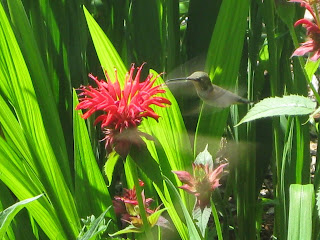Well, angst no more. Here’s an inexpensive, hand-crafted gift idea that
needs no glue gun, glitter, or any special supplies or tools: All-natural Face
and Body Cream. It’s a luscious, buttery cream that’s so easy to make, you just
might give up your store-bought products and starting making it for yourself!
All you’ll need are some nice oils, beeswax, plus some kind of liquid like a
tea or tincture, a little elbow grease, and voila!
Before I share the recipe, here’s a little background. When we first
moved to the Foothills, I discovered some handmade face cream made by Delle, a
local woman, who sold it at the village mom ‘n pop store. This cream was not
only moisturizing, but had healing properties too, like soothing bug bites,
scrapes, and any and all skin irritations. It was pretty pricey: $8 for a 4 oz
jar, but the cream was so amazing, and I was happy to support a local business.
Within a year or so, however, Delle pulled her product from the mom ‘n
pop to sell direct. Plus she raised the price to $14. The new price made me
blink a bit, but since I was well and truly addicted to this face cream by now
I had to have it. To order some, I phoned Delle, a fellow Foothills resident, and she
invited me to drop by her place to buy my supply.
John and I made the 20-mile trip via several twisty-turny country roads
to her house. After she showed us her garden where she raised many of her
ingredients, I happily purchased a couple more jars of her cream. But I
confess, when I did the math it wasn’t pretty. Forty miles of gas + an
afternoon away from my own garden work and writing + $28 for two small jars of
cream…Adding things up = time for a change.
I noted Delle’s ingredients: 5 kinds of high-quality oils and beeswax were
the first 6 listed. Green tea was number 8 or 9. Then I went online to find a homemade
skin cream recipe that looked similar. While I didn’t come across one with
Delle’s extensive list (which was okay, since she had so many components most
of them would probably contribute only tiny amounts), I did find a promising
recipe with pretty affordable ingredients.
 |
| Ingredients, including beeswax blocks and right-sized jars |
Since then, I’ve made my cream many dozens of times—John calls it “Sue
doing her alchemy”—and had great results. So here’s my method:
All-Natural Face Cream
½ oz. beeswax, finely chopped (I buy 1 oz. blocks at my local food
co-op)
6 tablespoons extra virgin olive oil
3 tablespoons almond oil (also purchased at the co-op)
½ cup distilled water
1 teabag green tea
A few drops Vitamin E
Small metal bowl
2 small heat-proof jars
 |
| One of Delle's original jars |
To sterilize the jars: Fill a large sauce pan with water and bring to a
boil. Gently ease the jars into the boiling water for a few minutes, then remove
with tongs and let cool.
A quick note on sterilizing: this cream has Vitamin E in it to act as a
preservative, but no chemical preservatives, unlike your drugstore brands.
Sterilizing isn’t strictly necessary, but doing this step does help your
product last longer without getting funky. (A side note: This recipe makes 2 jars, and I keep one jar in the fridge. During really hot weather, I keep my whole
supply in the fridge. Again, without chemical preservatives, the shelf life
isn’t long.)
Next, turn the heat down to medium-low. Pour out at least half the saucepan’s
water, then put the pan back on the burner, and rig it up as a double boiler. I
have a metal steamer that fits inside my largest saucepan, which works fine.
Pour the oils into the small bowl, place the bowl on your double boiler
and begin warming the oils. Into the warming oil goes your cut-up beeswax. With
the saucepan at a moderate simmer, melt the beeswax—this should take about 5-10
minutes—then immediately remove the bowl of melted beeswax and oils from heat,
and add several drops of Vitamin E.
While the beeswax is melting, make your liquid component. The original
recipe that inspired this one called for rose water, but since that’s hard to
find I’ve settled on green tea, which has antioxidants and a very light odor. Plus
Delle used it! Boil your ½ cup of distilled water, pour into a mug with the
teabag, and let it steep.
As soon as you’ve pulled your oil/melted beeswax off the heat, time to
carefully watch it! As the mixture cools, wax will begin to solidify around the
edge of the oil. Stir these bits of wax back into the oil to keep everything
melted. What you want is the mix’s sweet spot: not too hot, or your product
will be oily instead of creamy. But cool it too long, and tiny bits of hardened
beeswax will mar the smooth texture you’re aiming for. So just at that point
where the cooling beeswax isn’t quite melting back into the oil, pour in 3
tablespoons of semi-cooled green tea and start whisking!
I just whisk in the green tea with a fork, but you can use a proper
whisk, or even shake everything up in a jar. (If you’re read my previous
recipes, you’ll know I’m big on mixing by hand, not machine!) Whisk for about
10 minutes—either until the melted oils and tea has emulsified into a soft
yellow, with the texture of whipped cream—or your arm feels like it’s going to
fall off. When you’ve reached that lovely, buttery consistency, spoon the cream
into your prepared jars. It will continue to cool, and solidify just a bit.
The final step: prepare to delight your recipients…I firmly believe
that this cream gives your skin a luminous glow that store-bought products can
only hope for!








